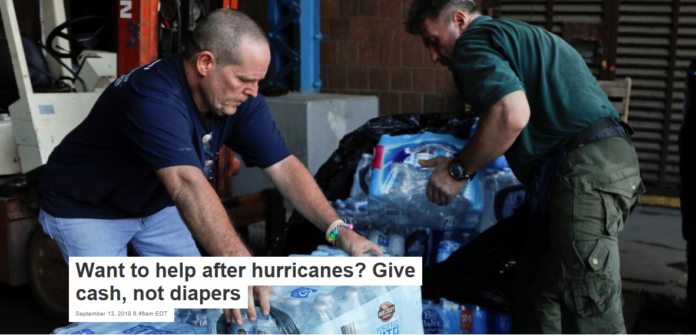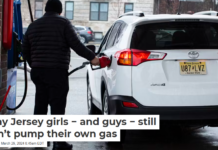

Julia Brooks, Harvard University
Some companies and community groups didn’t wait for Hurricane Florence to make landfall before organizing donation drives.
But as a researcher with the Harvard Humanitarian Initiative, an interdisciplinary center at Harvard University dedicated to relieving human suffering in wartime and disasters by analyzing and improving the way professionals and communities respond to emergencies, I wish they would have.
I’ve studied dozens of disasters, from Hurricane Maria and Superstorm Sandy to the South Asian tsunami and one thing is clear: In-kind donations of items such as food, clothing, toiletries and diapers are often the last thing that is needed in disaster-affected areas.
Delivering things that people need on the ground simply doesn’t help disaster-struck communities as much as giving them – and relief organizations – money to buy what they need. What’s more, truckloads of blue jeans and cases of Lunchables can actually interfere with official relief efforts.
If you want to do the greatest good, send money.
What’s wrong with in-kind donations
As humanitarian workers and volunteers have witnessed after disasters like Haiti’s 2010 earthquake and Southeast Asia’s Typhoon Haiyan in 2013, disaster relief efforts repeatedly provide lessons in good intentions gone wrong.
At best, in-kind donations augment official efforts and provide the locals with some additional comfort, especially when those donations come from nearby. When various levels of government failed to meet the needs of Hurricane Katrina victims, for example, community, faith-based and private sector organizations stepped in to fill many of the gaps.
How can in-kind donations cause more harm than good? Donated goods raise the cost of the response cycle: from collecting, sorting, packaging and shipping bulky items across long distances to, upon arrival, reception, sorting, warehousing and distribution.
Delivering this aid is tough in disaster areas since transportation infrastructure, such as airports, seaports, roads and bridges, are likely to be, if not damaged or incapacitated by the initial disaster, already clogged by the surge of incoming first responders, relief shipments and equipment.
This is especially the case in places like the Outer Banks, a string of barrier islands off North Carolina’s coast, where the challenges of bringing relief goods in, and distributing them to people who need supplies, are heightened by geography.
Dumping grounds
At worst, disaster zones become dumping grounds for inappropriate goods that delay actual relief efforts and harm local economies.
After the 2004 South Asian tsunami, shipping containers full of ill-suited items such as used high-heeled shoes, ski gear and expired medications poured into the affected countries. This junk clogged ports and roads, polluting already ravaged areas and diverting personnel, trucks and storage facilities from actual relief efforts.
After the 2010 earthquake in Haiti, many untrained and uninvited American volunteers bringing unnecessary goods ended up needing assistance themselves.
In-kind donations often not only fail to help those in actual need but cause congestion, tie up resources and further hurt local economies when dumped on the market, as research from the International Federation of Red Cross and Red Crescent Societies determined.
Research confirms that a significant portion of aid dispatched to disaster areas is “non-priority,” inappropriate or useless.
One study led by José Holguín-Veras, a Rensselaer Polytechnic Institute expert on humanitarian logistics, found that 50 percent to 70 percent of the goods that arrive during these emergencies should never have been sent and interfere with recovery efforts. After the 2011 Joplin, Missouri, tornado and the Tōhoku, Japan, earthquake, for example, excessive donations of clothing and blankets tied up relief personnel.
Relief workers consider these well-meaning but inconvenient donations as a “second-tier disaster” due to the disruption they cause.
What else can you do?
Instead of shipping your hand-me-downs, donate money to trusted and established organizations with extensive experience and expertise – and local ties.
Give to groups that make it clear where the money will go. Choose relief efforts that will procure supplies near the disaster area, which will help the local economy recover. You can also consult organizations like Charity Navigator that evaluate charities’ financial performance.
Many humanitarian aid organizations themselves have increasingly adopted cash-based approaches in recent years, though money remains a small share of overall humanitarian aid worldwide.
Evaluations of the effectiveness of such programs vary and are context-dependent. Nonetheless, emerging evidence suggests that disbursing cash is often the best way to help people in disaster zones get the food and shelter they need.
What’s more, the World Food Program and the U.N. High Commissioner for Refugees say that people affected by disasters tend to prefer cash over in-kind aid due to the dignity, control and flexibility it gives them.
Some exceptions
There are a few notable exceptions to this advice on avoiding in-kind donations.
If you live in or near the affected area, it is helpful to consider dropping the specific items victims are requesting at local food banks, shelters and other community organizations. Just make sure that the items won’t perish by the time they can be distributed. For areas in Hurricane Florence’s path, for instance, the Red Cross has requested blood donations.
Charity is a virtue. Particularly when disaster strikes, the urge to help is admirable. Yet this impulse should be channeled to do the greatest good. So please, if you would like to help from afar, let the professionals procure goods and services. Instead, donate money and listen to what people on the ground say they need.
And don’t stop giving after the disaster stops making headlines. A full recovery will take time and support long after the emergency responders and camera crews have moved on.
This is an updated version of an article originally published on Sept. 4, 2017.![]()
Julia Brooks, Researcher in international law and humanitarian response, Harvard Humanitarian Initiative (HHI), Harvard University
This article is republished from The Conversation under a Creative Commons license. Read the original article.



















